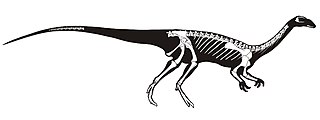
Saturnalia is an extinct genus of basal sauropodomorph dinosaur known from the Late Triassic Santa Maria Formation of Rio Grande do Sul, southern Brazil. It contains one species, Saturnalia tupiniquim. It is one of the earliest known dinosaurs.
José Fernando Bonaparte was an Argentine paleontologist who discovered a plethora of South American dinosaurs and mentored a new generation of Argentine paleontologists. He has been described by paleontologist Peter Dodson as "almost singlehandedly...responsible for Argentina becoming the sixth country in the world in kinds of dinosaurs."

Guaibasaurus is an extinct genus of basal saurischian dinosaur known from the Late Triassic Caturrita Formation of Rio Grande do Sul, southern Brazil. Most analyses recover it as a sauropodomorph, although there are some suggestions that it was a theropod instead. In 2016 Gregory S. Paul estimated it at 2 meters and 10 kg, whereas in 2020 Molina-Pérez and Larramendi listed it at 3 meters and 35 kg.
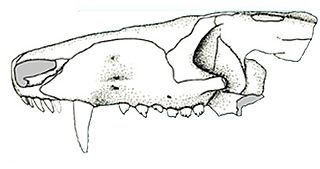
Prozostrodon is an extinct genus of probainognathian cynodonts that was closely related to mammals. The remains were found in Brazil and are dated to the Carnian age of the Late Triassic. The holotype has an estimated skull length of 6.7 centimetres (2.6 in), indicating that the whole animal may have been the size of a cat. The teeth were typical of advanced cynodonts, and the animal was probably a carnivore hunting reptiles and other small prey.

Guaibasauridae is a family of basal sauropodomorph dinosaurs, known from fossil remains of late Triassic period formations in Brazil, Argentina and India.
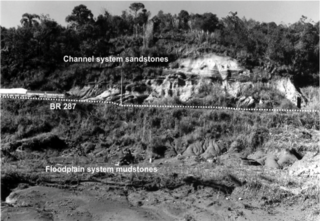
The Santa Maria Formation is a sedimentary rock formation found in Rio Grande do Sul, Brazil. It is primarily Carnian in age, and is notable for its fossils of cynodonts, "rauisuchian" pseudosuchians, and early dinosaurs and other dinosauromorphs, including the herrerasaurid Staurikosaurus, the basal sauropodomorphs Buriolestes and Saturnalia, and the lagerpetid Ixalerpeton. The formation is named after the city of Santa Maria in the central region of Rio Grande do Sul, where outcrops were first studied.
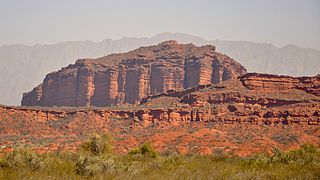
The Los Colorados Formation is a sedimentary rock formation of the Ischigualasto-Villa Unión Basin, found in the provinces of San Juan and La Rioja in Argentina. The formation dates back to the Norian age of the Late Triassic.

The Caturrita Formation is a rock formation found in Rio Grande do Sul, Brazil. Its sediments were deposited in the Paraná Basin. The formation is from the Upper Triassic and forms part of the Santa Maria Supersequence in the upper section of the Rosário do Sul Group.
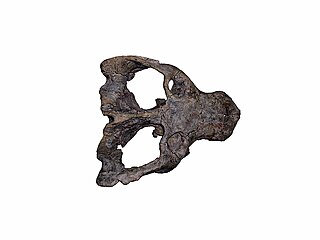
The Paleontological Site Arroio Cancela is located within the city of Santa Maria, a municipality of Rio Grande do Sul, the southernmost state of Brazil. The site is situated in the neighbourhood Nossa Senhora de Lourdes at an altitude of 107 metres above sea level. The fossils have been discovered within the sediments of the Santa Maria Formation, they are vertebrates from the Triassic period and are about 225 million years old.

Candelária is a municipality in the state of Rio Grande do Sul, Brazil.

Daniel Cargnin (1930–2002) was a Brazilian priest and amateur paleontologist born in Nova Palma, in the state of Rio Grande do Sul, Brazil, in 1930. He died in 2002, and at his request was buried in the town of Mata.
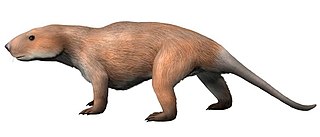
Riograndia is an extinct genus of prozostrodontian cynodonts from the Late Triassic of Brazil. The type and only species is Riograndia guaibensis, named after the State of Rio Grande do Sul and Guaíba Basin, where it was discovered. Remains have been found in the Caturrita Formation of the geopark of Paleorrota. It was a small non-mammalian cynodont, with several advanced features also present in mammals. Several specimens of Riograndia guaibensis have been found in the towns of Candelária and Faxinal do Soturno in the Caturrita Formation. The genus defines the Riograndia Assemblage Zone.

Protheriodon is an extinct genus of probainognathian cynodonts which existed in the Santa Maria Formation of the Paraná Basin in southeastern Brazil during the middle Triassic period. It contains the species Protheriodon estudianti. It was first described by Argentine palaeontologist José Bonaparte, who assigned it to the family Brasilodontidae. More recent studies have however recovered it in a more basal position than other brasilodontids, just outside Prozostrodontia.

Irajatherium is an extinct genus of cynodonts, known only of the type species Irajatherium hernandezi. It is named in honor of Irajá Damiani Pinto.
Faxinalipterus is a genus of ornithodiran archosaur, originally described as a pterosaur, from the Late Triassic Caturrita Formation of southern Brazil. A study from 2022 reinterpreted the fossil remains and instead suggests them to belong to a member of the Lagerpetidae, another clade of pterosauromorphs.
Barberenasuchus is an extinct genus of an archosauriform. Fossils have been found from the Santa Maria Formation of southern Brazil of Late Triassic age. Its phylogenetic position within Archosauriformes is uncertain; the author of its description classified it as a sphenosuchid crocodylomorph, while Kischlat (2000) considered it to be a rauisuchian. Irmis, Nesbitt and Sues (2013) stated that they "could not find any crocodylomorph character states preserved in the holotype specimen". Based on the presence of an antorbital fenestra the authors assigned Barberenasuchus to Archosauriformes, but stated that without further preparation and study it is not possible to assign it to any specific archosauriform group. It is named in honor of Mário Costa Barberena.
Pampadromaeus is an extinct genus of basal sauropodomorph dinosaurs known from the Late Triassic (Carnian) Santa Maria Formation of the Paraná Basin in Rio Grande do Sul, southern Brazil.
Dromatheriidae is an extinct family of prozostrodontian cynodonts, closely related to mammals. Members of the family are known from the Late Triassic of India, Europe and North America. Apart from a few jaw fragments, dromatheriids are mainly known from their sectorial (flesh-slicing) postcanine teeth. The teeth were fairly typical among early prozostrodontians, as they were labiolingually compressed, with a single root and crown hosting a longitudinal row of sharp cusps. Dromatheriids in particular have a very narrow and symmetrical crown without a prominent cingulum.
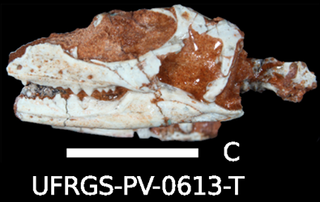
Microsphenodon is an extinct genus of sphenodontian from the Late Triassic of Brazil. The type species is Microsphenodon bonapartei. It is a small sphenodontian with a skull roughly 20 mm long, and represents a unique mosaic of characteristics shared by both early diverging sphenodontians and eusphenodontian characters. Specimens of this taxon were first identified by Bonaparte and Sues (2006) but were misidentified as juvenile Clevosaurus brasiliensis, characteristics such as differences in the configuration of the teeth on the palate, and the unique form of tooth implantation seen in C. brasiliensis, helped differentiate these two co-occurring sphenodontian taxa.

Maehary is an extinct genus of probable gracilisuchid pseudosuchian archosaurs from the Late Triassic (Norian) Caturrita Formation of Rio Grande do Sul, Brazil. The genus contains a single species, M. bonapartei, known from a partial skull and fragmentary postcrania. Maehary was originally described as the basalmost member of the Pterosauromorpha, but several subsequent studies have suggested pseudosuchian affinities are more likely. If this is correct, it would represent the youngest known member of the Gracilisuchidae.




















